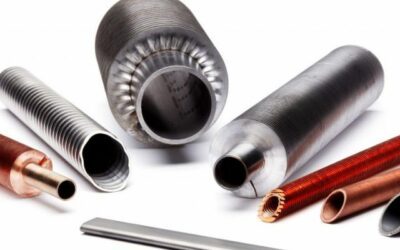Want more heat exchange power from your fin tube? Of course you do.
When it comes to heat exchangers, chillers, and boilers, we’re always looking to raise the bar on performance. That’s where twisted tape turbulators come in. They’re yet another tool in our arsenal to optimize the heat exchange performance of a fin tube.
What is a Twisted Tape Turbulator & What Does It Do?
[/vc_column_text][vc_empty_space][vc_empty_space][vc_column_text]A twisted tape turbulator is an internal tube baffle made of helically shaped metal strips. It breaks up the laminar boundary of the fluid, gas, or other medium in the fin tube, turning it into a spiraling, turbulent flow. A twisted tape turbulator causes the fluid, gas or medium to mix and tumble in an irregular current, effectively mixing the medium and enhancing the rate of heat transfer.
Flow is considered laminar when the velocities are free of random fluctuations through the flow field — creating a highly ordered fluid motion that is streamlined. Flow is considered turbulent when fluid particles don’t travel in a well-ordered manner — the fluid or gas mixes randomly, increasing the rate of heat transfer.
A twisted tape turbulator is a tool to enhance heat transfer in a fin tube. It is added to the inside of a fin tube, or even a smooth outside surface tube, to spiral the flow of the medium to optimize heat transfer capabilities and fin tube performance. This delivers better efficiency for your fin tubes, heat exchangers, boilers, and chillers.
The general rule is the greater the turbulence, the better your rate of heat transfer.[/vc_column_text][vc_empty_space][vc_single_image image=”3898″ img_size=”400 x 250″ alignment=”center” style=”vc_box_border_circle” border_color=”black”][vc_empty_space][vc_column_text]
The Importance of Twist Pitch or Twist Count
[/vc_column_text][vc_empty_space][vc_column_text]The twist pitch, sometimes known as the twist count, is the length of one complete revolution of rotation in a twisted tape turbulator inside of a fin tube.
The twist pitch is provided by the customer. Through a finite analysis of heat exchanger design or controlled testing, you determine how much turbulence is needed in order to create the precise amount of mixing required.
How much pitch you need depends on your heat transfer needs, as well as the limits of the inside of the diameter of the tube. You don’t want to twist the turbulator so tight that it results in too much back pressure. A tube with too much back pressure could potentially require an increased pump size or a larger unit.
You will still need enough clearance to slide the turbulator in and out of the tube during the application process.
Ask yourself: What kind of turbulence is required? A high amount of turbulence will require a tight pitch. If you don’t need a high degree of turbulence but just want to disrupt the laminar flow, a sweeping lazy pitch will do. This way, you don’t have to change the design or greatly increase the design of the blower or pump.[/vc_column_text][vc_empty_space][vc_column_text]
Tube Stops for Easy Application in Twisted Tape Turbulators
[/vc_column_text][vc_empty_space][vc_column_text]The twisted tape turbulators slide into the finned tubes. To allow for easy application, Energy transfer can place holes or T-Stops into the end of the turbulators. This way it is easy to slide the twisted tape turbulator in and out of the fin tube.
T-stops can be added to one end of the turbulator. A T-stop is a piece of sheet metal perpendicular to the turbulator. It is in the shape of a T-bar. This piece of plate ensures the turbulator stops at the end of the tube.
We include a small hole at the end of the turbulator through which we hook a hire to easily pull the turbulator into the fin tube for convenient application. [/vc_column_text][vc_empty_space][vc_column_text]
Primary Applications for Twisted Tape Turbulators
[/vc_column_text][vc_empty_space][/vc_column][/vc_row][vc_row][vc_column width=”1/2″][vc_column_text]Twisted tape turbulators are commonly used in fin tubes installed in boilers, heat exchangers, and chillers — pretty much anything in the chemical industry, the boiler industry, and the cooling industry. The biggest users of twisted tape turbulators are the boiler industry and HVAC Industry.
Turbulators are often used in boilers, especially fire tube boilers used for heating gasses. A fire tube boiler has a burner at the end of the fin tubes that contains the hot conbustion gasses. The hot gas goes straight through the fin tubes at a high velocity through these burners. The turbulators spin the hot gasses to increase the turbulence and the rate of heat exchange inside the fin tube.[/vc_column_text][/vc_column][vc_column width=”1/2″][vc_single_image image=”3869″ img_size=”large” alignment=”center” style=”vc_box_border_circle” border_color=”black” css=”.vc_custom_1618330134892{margin-top: 20px !important;}”][/vc_column][/vc_row][vc_row][vc_column][vc_column_text]
Material Considerations for Twisted Tape Turbulators
[/vc_column_text][vc_empty_space][vc_column_text]The material of a twisted tape turbulator has to first withstand the rigors of whatever medium is being put through the finned tube. Secondly, it must weather the required temperatures. And thirdly, it has to tolerate contact with the fluids.
For example, you wouldn’t choose aluminum to cool a substance that eats aluminum, or copper for a substance adverse to copper. If you are heating or cooling an oil, you’ll need a material with a chemistry that is ideal for contact with that oil. Often, the material for the twisted tape turbulator would match the tube material in the finned tubes, or at least be adaptable to the material of the fin tube itself.
The material used for turbulators will also need to be readily formable. Formable alloys such as copper, aluminum, carbon steel or stainless steel are ideal materials for turbulators inside of fin tubes.[/vc_column_text][vc_empty_space][vc_column_text]
Why Energy Transfer for Twisted Tape Turbulators?
[/vc_column_text][vc_empty_space][vc_column_text]What makes Energy Transfer a better choice for turbulators over other manufacturers in the industry?
Simple. Twisted tape turbulators provide an added value to the fin tubes we are already making. Why shouldn’t you get them from the same resource you purchase your fin tubes?[/vc_column_text][vc_empty_space][vc_single_image image=”3875″ img_size=”full” alignment=”center” style=”vc_box_border_circle” border_color=”black”][vc_empty_space][/vc_column][/vc_row][vc_row][vc_column][vc_column_text]Because we already manufacture the finned tube, you can have the twisted tape turbulator from a singular manufacturing resource in a bundled package. You don’t need to repeat steps in the sales process or work with multiple manufacturers. As a buyer, you get reduced costs through bundled pricing — and you don’t have to pay twice for shipping. This reduces costs substantially.
Because of our high degree of manufacturing output for fin tubes, we can manufacture twisted tape turbulators at an affordable price point. We maintain custom equipment to make turbulators through a simple but effective design that’s supremely economical.
Since we use our own tooling, we have essentially unlimited capacity when it comes to supply chains. We can adjust our turbulator manufacturing to meet any demand. We provide a wide degree of flexibility at a reasonable price point that is highly competitive in the finned tube industry.
Our in-house tooling reduces costs. Our connections to suppliers reduce overhead. At Energy Transfer, we do whatever we can to help you, the customer, save money on your fin tube. And that’s the Energy Transfer difference.[/vc_column_text][vc_empty_space][vc_separator color=”black” border_width=”3″][vc_empty_space][vc_column_text]
Have a question about fin tubes? We’re happy to help! Schedule a FREE consultation!
[/vc_column_text][vc_empty_space][/vc_column][/vc_row][vc_row][vc_column][vc_column_text]

Download Our Free Finned Tube Buying Guide
Want to build a seamless fin tube? Our FREE GUIDE tells you everything you need to know. Download yours today![/vc_column_text][vc_empty_space][/vc_column][/vc_row][vc_row][vc_column][vc_column_text]


